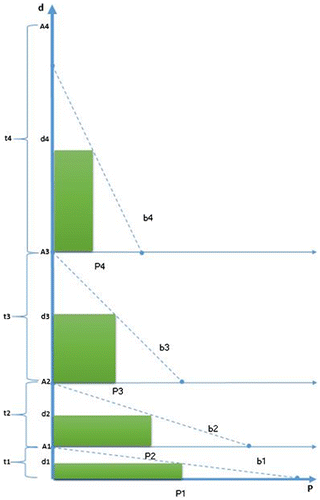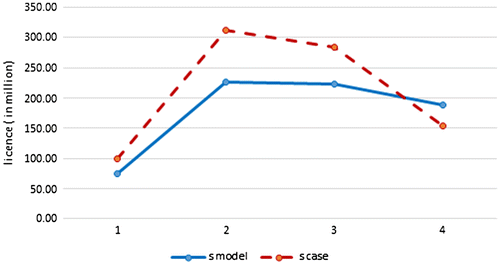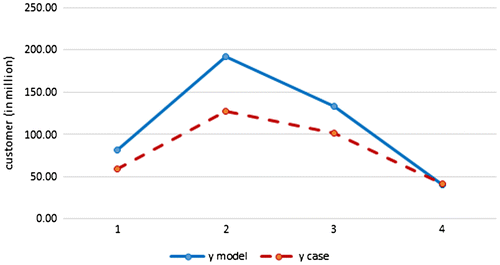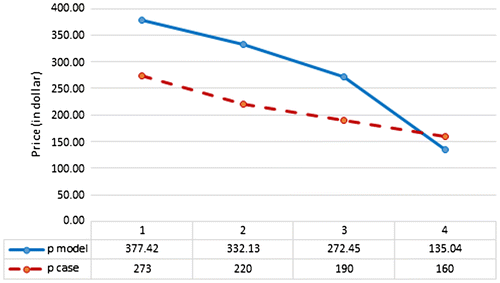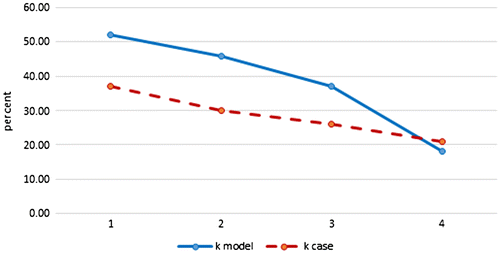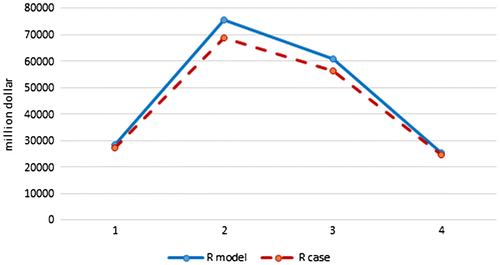 ?Mathematical formulae have been encoded as MathML and are displayed in this HTML version using MathJax in order to improve their display. Uncheck the box to turn MathJax off. This feature requires Javascript. Click on a formula to zoom.
?Mathematical formulae have been encoded as MathML and are displayed in this HTML version using MathJax in order to improve their display. Uncheck the box to turn MathJax off. This feature requires Javascript. Click on a formula to zoom.Abstract
This paper develops an optimization model for pricing a monopolistic application software in the presence of piracy. The purpose is raising revenue produced by product’s sale with determining prices in a price skimming strategy and minimizing amount of piracy. The model is a multifunctional price skimming optimization with simplex method which accompanied by a deterministic method for calculating time intervals of each segment. A linear function is used to describe demand of each segment. In addition, a linear piracy function is proposed to make piracy a dynamic parameter. The model has the ability to apply penetration pricing and controlling market share. Rough estimates of Windows 7 sale’s parameters are used to apply in the model. Optimizing case of Windows 7 is resulted in 7.3 percent increase in revenue while value of net market share is virtually constant. Therefore, the developed model demonstrates its competence in optimizing revenue by determining prices with presence of piracy. Results of the research show that to tackle piracy, range of price skimming must be decreased in a way that highest price need to be intensely reduced while lowest one must be slightly reduced. The benefit of using this strategy, is incurring lowest revenue loss due to piracy. The Effects of an escalation in piracy on proposed optimization model include increase in number of sale, demand, selling portion, market share, and decrease in price, price difference between segments, and revenue.
Public Interest Statement
Piracy make the pricing of software complex. Many researchers try to categorize piracy and calculate the willingness of customers to pirate products and estimate number of pirated software to take its effect into their software pricing models. But describing the changing status of software market is an awkward task which results in models which have many simplifying premises and are mainly impractical and subsequently remain to use as bases for future researches. To address the need of a pragmatic and flexible model for describing software market an optimization price skimming model is developed to help the software companies to assign multiple prices to a product during its life cycle. In addition, it allows companies to minimize and control piracy. The model do not impel limitative assumptions and do not need data which are arduous to be acquired. The model is tested by pricing Windows 7 and the results were rewarding.
1. Introduction
Software industry has some unique characteristics. It is more international in nature than any other industry. Software can be developed by distributed teams working almost anywhere in the world, and sold over the Internet in seconds, at negligible cost which is the reason of near zero marginal cost of an additional copy (Buxmann & Hess, Citation2012).
Availability of software in low price for customers dims amount of piracy. This is attributable to the fact that the most common reason for pirating software is the high cost of legal software (Cheng, Sims, & Teegen, Citation1997). Price skimming increases availability of software in low price; therefore, it can address the need for lowering piracy number. It should mention that price skimming can only be used in a monopolistic market (Khouja, Hadzikadic, Rajagopalan, & Tsay, Citation2008). Price skimming is used for software due to several reasons. First, regarding to its nature it has a decreasing value until it gets zero price due to losing compatibility (Buxmann & Hess, Citation2012). Second, it rises the penetration rate of product. Third, it boosts number of users by network effect. Forth, skimming helps to implement a value base pricing (Lehmann & Buxmann, Citation2009). There is a tradeoff between sale and margin in each segment of a skimming method (Khouja et al., Citation2008). Skimming raises margin and piracy reduces sale and compresses price range of skimming. This tradeoff has been addressed by an optimization model in the current study.
Chopra and Meindl (Citation2010) gives a multifunctional price skimming model to identify the appropriate price for each customer segment for implementing differential pricing. This model encompassed inventory and is not directly useful for software. However, the idea is used in the current study for describing demand of heterogeneous customers. Although not prevalent and with many limitations, there are several papers which are dedicated to pricing of information goods in presence of piracy. Liu, Cheng, Tang, and Eryarsoy (Citation2010) presents multi-period software pricing model with a price skimming strategy which can be solved by exhaustive search. Revenue is decreased in each period by multiplying revenue and a multiplier which is not dependent on price and therefore the model is not practical. Kogan, Ozinci, and Perlman (Citation2013) consider a monopolistic producer offering software that is updated periodically; however, by the end of the first period, a pirated version is available at a transaction cost. The author has tried to give pricing model to reduce amount of piracy by using algebra and analytical solution. Waters (Citation2013) in his paper presents an information good pricing model with heterogeneous consumers. In the Waters’s research, although numerical computations are calculated for software, model is generally presented for digital goods. Moreover, it does not consider specifications of market, sale and product which is resulted in a vague, unaimed model. Assumptions of the model are too limitative. Identical to other similar researches, waters have failed to put forward a practical model as a constant price decrease for sections is considered. There is not an optimization price skimming model for applications software in the literature. Available models in literature have used mathematical methods including analytical solution, and exhaustive search but not simplex. In addition, limitative assumptions make models far from reality. Furthermore, they are intricate and complex which are difficult to use. Common models for tangible goods cannot be used for software because they are based on inventory. Therefore, a practical model which be able to properly describe the real situation of market is required.
The objective of the study is presenting a deterministic price skimming model for software with existence of piracy in order to maximize revenue by determining prices in a dynamic situation of market. Furthermore, obtaining time interval of customer’s pricing segments.
In the current research, a monopolistic market is selected due to the fact that dynamic pricing is only applicable on monopolistic market. Customers are strategic. Purchasing license of application is considered in this research. By this choice, product is perishable, durable and therefore there is a finite sale horizon. In fact, we face with a finite-population model that assumes a random process without replacement. There is a finite (possibly random) number of customers with heterogeneous willingness to pay values. Windows 7 is used as the case study. Strategy of minimum toleration for piracy is chosen as it is suggested in the literature (Lahiri, Citation2012).
2. Method
Revenue management often relies on the premise that different customers are willing to pay different amounts for a product (Talluri & Van Ryzin, Citation2005). This bring concept of segmentation to mind. Customers are segmented into groups with similar preferences and price responses. We assume that number of segments in a market and demand function of each segment is given. It is must be noticed that every segment have unique demand function which describes characteristics of its attributed segment. It means that demand is known for every given price and segment. In the price skimming technique, customers with inelastic demand are satisfied first followed by elastic demand at the end of product lifecycle. Therefore, the first function has highest elasticity and it decreases as we go toward the last function. An assumption is taken that there is not loss in demand and by that unfulfilled demand of one segment is shifted to the next segment. It is because of the fact that customers may postpone their order to get the lower prices.
Four common demand functions (logit, log-linear, constant elasticity, linear) are examined to apply in price skimming model. Linear function is determined as a plausible function to use. A schematic sketch is depicted in Figure to show the change of elasticity, demand, and price during successive periods. Four functions for four segments are shown. Rectangulars show highest revenue that can be skimmed from each segment. P1, P2, P3, P4 are price finite optimizers and d1, d2, d3, d4, are demand finite optimizers. b is gradient of demand curves. And t shows time intervals of periods. The more the gradient, the more the sensitivity to price. Therefore, the first segment have the highest price which reduces gradually toward the last segment. This method of segmentation is used for describing a heterogeneous customer demand. Based on that an optimization model is developed. Then pricing of Windows 7 is carried out by solving the model by the Excel Solver.
3. Theory and calculation
In this section, a deterministic, dynamic model is represented for determining optimum prices in dynamic situation of bazar. Time intervals between every two successive prices are obtained by deterministic method. Talluri and Van Ryzin (Citation2005) supports using deterministic method in his well-known book “Revenue management”. He states that “The solution produced by the deterministic dynamic-pricing problem is a reasonably good heuristic for the stochastic-pricing problem. Numerically, it performs well, and theoretically it can be shown to be asymptotically optimal for problems with large demand volumes (Talluri & Van Ryzin, Citation2005).” Such properties provide support for using deterministic models as a reliable solution for pricing problems.
Piracy and penetration rates are two prominent factors which considered in this model. They are explained in detail with regard to their effect on price and demand of segments.
Variables of model are introduced as follow.
Table
Objective function of model is which is sum of multiplying price and sale of each segment. When equations of price and demand are plugged into objective function Equation (4.1) is gained. Demand function of segment i is defined by di = Ai − Bipi and percentage of piracy for segment i is given by
.
(1)
(1)
subject to:(2)
(2)
Lowest market share constraint:
(3)
(3)
Highest market share constraint:
(4)
(4)
Minimum price difference constraint:(5)
(5)
Minimum penetration constraint for segment i:(6)
(6)
when di and (average number of customers arrived in a time unit) are available, time interval of period i can be calculated by
.
The optimization model gives maximum total revenue with finding optimum amounts of demand and price for each segment. In fact, revenue of each segment becomes maximized and revenue loss due to piracy becomes minimized. Model can be solved with nonlinear optimization algorithms like GRG in excel solver. Amount of piracy is produced by a linear piracy function which gives a different percentage of piracy to each segment based on a given price. Therefore, each segment gets a specified amount of revenue loss due to piracy.
3.1. Model’s constraints
There must be a lowest market share constraint () in case of requiring a penetration pricing strategy. Total demand of product must be more than a minimum desired share of market (D0). If it is needed, model brings the price lower to raise demand and prevents demand to be lower than D0.
Highest market share constraint can be used in several instances. It can be used if there is a forecasted or expected demand. Another case is when software’s vendor want to limit the total number of sales for a version of product.
Dedicated prices to segments make the segments different from each other. As the result, prices must be different enough to make customers to treat according to their specified segments and consequently the segments be meaningful. Therefore, Minimum price difference constraint is considered to keep the prices in meaningful distances. The constant C can be attained by previous pricing experiences and marketing studies.
Minimum penetration constraint for segment i (di ≥ d0i) gives ability to producer to control penetration rate in every segment. It is particularly useful when producer wants to push to make a version of its application penetrate market in the start of a product release and also to decrease share of previous versions.
This optimization model gives maximum total revenue with finding optimum amounts of demand and price for each segment. As a result, revenue of each segment becomes maximized and revenue loss due to piracy becomes minimized. Model is nonlinear and can be solved with nonlinear optimization algorithms like GRG in excel solver. Amount of piracy is produced by a linear piracy function which gives a different percentage of piracy to every segment based on a given price. Therefore, each segment gets a specified amount of revenue loss due to piracy.
3.2. Piracy function
Piracy is dependent to price and demand. Due to difference of price in each segment amount of piracy also differ. In order to describe dependency of price and piracy volume a linear function is suggested in which percentage of piracy is a function of price. Equation of the function is . In that l is gradient of piracy function, p0 is a price in which piracy is zero, and k is percentage of piracy.
Windows 7 is chosen for analysis due to availability of data and being a successful product which its lifecycle is virtually completed. In addition, windows has a monopolistic market since 91 percent of personal computers (PCs) run windows as their operating system. Data include nonofficial average prices of different Windows 7’s editions including Home Premium, business and ultimate in each segment (arstechnica.com, Citation2009), number of PCs sold every year (gartner.com, Citation2015; statisticbrain.com, Citation2015), approximate number of Windows 7 sold (Gruener, Citation2011; LeBlanc, Citation2010; statista.com, Citation2014; Thurrott, Citation2011; Warren, Citation2012; Whittaker, Citation2012), life cycle of Windows 7 (microsoft.com, Citation2014). Table represents these data in a time span of 50 months that is from October 2009 until December 2013. Retail Windows 7 end of sale is October 31, 2013. Despite the fact that Windows 7’s number of sale for 2014 is not published yet, its life span was almost finished in 2013 because its retail sale was ended.
Table 1. Microsoft Windows 7 and PC sales information (sale numbers are in million)
Bold numbers in Table are informal estimations of cumulative number of Windows 7’s license sold which can be found in the Internet. Other numbers in that column are calculated by . am and bn are two successive bold numbers and n and m are attributed month numbers of am and bn. In the Table different segments are separated by different colors. Table gives the results of calculations on the data of Table . Calculated piracy rate for each segment (k) and piracy percentage of windows 7 are also added to Table .
Table 2. Market parameters
Table represents net market share of Windows 7 from sold PCs after launch of Windows 7. Net market share is used instead of market share because number of PCs produced before launch of Windows 7 does not have contribution in both solving the model and comparison of important portions. Furthermore, it makes calculation complicated. Net market share and other market analysis parameters are defined in following.
| • | Net market share is defined as summation of sold Windows 7’s and pirated ones divided by sold PCs after Windows 7 launch. | ||||
| • | Selling portion is number of sold Windows 7 divided by number of sold PCs. | ||||
| • | Percentage of piracy in number is gained by | ||||
| • | Piracy loss is gained by | ||||
| • | Percentage of piracy loss is gained by | ||||
| • | Revenue is gained by | ||||
Table 3. Market analysis of Windows 7
3.3. Building demand functions
Based on demand and price of Windows 7, four demand functions must be built for four segments. It needs to calculate parameters of linear functions which are A and b.
A is gained by following formula:(7)
(7)
which pci is number of PCs produced in segment i. Following equations give amount of di:(8)
(8)
(9)
(9)
(10)
(10)
From Equations (7) and (10) we have: Ai + 1 = Ai − si − yi + pci + 1.
In order to ensure that optimization model gives correct answer, optimum values of demand and price are gained by arithmetic microeconomic techniques and comprised with answer of optimization model in Section 3.6. It can be done just for a case without parameter of piracy. Therefore, values of A and b should be calculated for demand functions with and without piracy.
If piracy is zero, then Ai can be achieved by Ai + 1 = Ai − si + pci + 1. Values of Ai is represented in Table . Remnant is number of people who don’t buy windows in each segment. Since we have strategic customers, Remnant’s number must be add to number of customers in the next segment. Proceeding formula gives value of Remnant in hand.(11)
(11)
Table 4. Without piracy (numbers are in million)
Remi is number of people in segment i who neither buy nor pirate. In Table , piracy is zero and remnant is gained by Remi = Ai − si.
Remi in Table is calculated by Equation (11). Ai can be also calculated by embedding di from Equation (7) to (8). Then following equation can be get:(12)
(12)
Table 5. With piracy (numbers are in million)
From Equations (8) and (9) yi can be gained; .
In Table , b is gradient of linear function when there is not piracy. This is calculated by following equations:(13)
(13)
Table 6. Demand functions without piracy
Table depicts demand functions which describe treatment of customers of Microsoft Windows 7. Gradient of functions are gained by .
Table 7. Demand functions with piracy
Piracy function is introduced by . p0 is assumed 10 $.
Piracy of Windows 7 is 28%. The way which 28% is attained is explained in following. Consider . Approximately 91% of PCs are ran by windows, so number of windows driven PCs in considered period of this research is result of multiplying number of produced PCs (1389.8) by 0.91. Based on Table , estimated number of sold Windows 7 licenses is 851.1 million. It is roughly estimated that in 2013 around 60 million license of Windows 8 which do not include upgrade to Windows 8 from Windows 7, are sold. Therefore, number of pirated Windows 7 is gained by 1389.8 × 0.91 − (851.1 + 60). Number of windows vista and xp sold in the period is considered zero. Finally, percentage of piracy is number of pirated Windows 7 divided by number of windows driven PCs.
For building linear piracy function of Windows 7 amount of l must be calculated. It is done by finding l in following formula.
(14)
(14)
Demand of Windows 7 which is defined by total number of sold and pirated windows is . As a result, l can be gained by 1182.083 = 100/(1 − 263 l) + 300/(1 − 210 l) + 296.66/(1 − 180 l) + 154.44/(1 − 150 l). Solving the equation in the MATLAB results in = 0.001420695. Thereby, percentage piracy function for Windows 7 is obtained as
.
3.4. Solving the case study via revenue optimization model
Table is indicated data resulted from solving the case with demand and piracy functions which have been presented so far. Microsoft Excel solver is used to maximize revenue of sailing Windows 7. Furthermore, since model is nonlinear, GRG algorithm is chosen which uses simplex method to solve nonlinear problems.
Table 8. Results of solving Windows 7 pricing model
Several fix parameters are used which they consist of D0, p0, d0i, C. These parameters are introduced in continue. D0 = 0.18 pcs is lowest market share which is selected for Windows 7. It is because of the fact that between all the windows, lowest market share which is acquired by windows Vista is 18% (w3schools.com, Citation2015). d0i = 0.1 pcsi is minimum penetration rate for segment i. 0.1 is chosen because minimum market share of Windows 7 between all PLC stages is 0.1 (w3schools.com, Citation2015). C is minimum percentage of price difference which is allowed between two successive segment’s prices. For Windows 7 minimum price difference is between segments 2 and 3, so value of C is obtained by (220 − 190)/220 = 0.136.
Deterministic optimization model for obtaining optimum prices and revenue is represented below. For that numbers which have been obtained for variables are plugged in Equation (1) until (6).
Subject to:
In calculating piracy loss, it is assumed that if there is not piracy in segment i, di is sold at price pi. Therefore, with existence of piracy yi is lost with price of pi.
3.5. Deterministic time intervals
Time interval of periods are obtained by in Table .
is average monthly demand for segment i which is gained by dividing di by duration of segment i in month. Note that time intervals cannot be calculate by si. Because piracy and sale take happen simultaneously during time. Average monthly demands and length of segments for Windows 7 are available in Table .
Table 9. Deterministic time intervals
3.6. Validation of the model
Validation of model is done by comparing the results of the optimization model with results of microeconomic techniques. Moreover, results of solved Microsoft case are compared with other papers.
There is an arithmetic solution to obtain optimum prices and revenue of linear demand functions. Although that cannot be used to solve a model which contains piracy, it gives a way to show presented model is matched with current proved mathematical solutions.
Linear demand function has a finite price optimizer p0 = a/2b and a finite demand optimizer d0 = a/2 (Talluri & Van Ryzin, Citation2005). Consequently, it gives maximum revenue as max R = a2/4b. Table contains results of applying above formulas. Column p% shows segments’ price difference which all are more than 0.136 and acceptable. Values of bi and Ai are brought from Table .
Table 10. Microeconomic solution results
Table indicates prices and revenue calculated by optimization model below.(15)
(15)
Table 11. Model results
As it can be seen the results of calculation with both solutions are exactly the same. Therefore, it verifies correctness of model when piracy is zero.
3.6.1. Compressing price range by piracy
When we draw an analogy between the results of presented model which are computed by different amounts of piracy it can be seen that piracy compresses price range of price skimming strategy. For showing that, a percentage piracy function of is assumed and model is solved with optimization objective function of (16). Results are shown in Table which in comparison with Table has smaller price range. Furthermore, the more the piracy, the less the price difference between segments. Price ranges in Tables and are 218 and 123 respectively. Thus, deference of their price range is 218 − 123 = 95. The same result is gotten by James Waters (Citation2013) while he try to pricing information goods in 2013. He reported that piracy compressed price reduction plan.
Table 12. Compressed prices
4. Results and discussion
Table depicts a comparison of market parameters between data of Windows 7’s case and the results of the optimization model. Revenue and market share are important parameters of selling software which are compared in Tables and . As can be seen in Table net market share of model remains almost the same, and produced revenue of selling Windows 7 (Table ) is increased 7.3% by the optimization model. This illustrates effectiveness and profitability of using the model for pricing a monopolistic software. Piracy rises by 4% while revenue loss due to piracy is increased by 43.6%. It implies that optimized state is to have more prices and consequently more piracy for first segments while low price and piracy for last segments. It is described in detail for each segment in the next section. Additionally, selling portion is decreased by 10% but this parameter is trivial. The data in Tables and can be found in Tables and .
Table 13. Market analysis of Windows 7
Table 14. Revenue
Tables and demonstrate values of p,d,s,k and y for all segments which are obtained by model and real case. Thereafter, for every parameter a chart is provided to comprise and show differences of optimized state with current state.
Table 15. Optimized variables
Table 16. Current variables
Figures and illustrate Windows 7’s sale and piracy values of model vs. case for each segment. It can be seen that model suggests higher prices and consequently lower sale for first three segments and lower price and higher sale for the fourth segment. Moreover, piracy is kept higher for first three segments by model than what case values are. Hence, it can be deducted that revenue loss due to piracy is mostly related to first segments which have higher prices and piracy rates. Figure shows that highest numbers of piracy are for second and third segments which have highest demands and accordingly highest duration of sale.
Figure presents demand values of model and case. As it is apparent both demand curves have the same trend. Demand of the third and fourth segments are modified by model in which the third demand becomes lower and the fourth one becomes higher.
Main variable of the model is price which other variables are depend on. In fact, with changing price other variables like demand, piracy, sale, and revenue are able to be controlled. Figure shows Windows 7’s price real values vs. optimized values. Optimization model suggests a more aggressive price skimming model with higher prices for first three segments and lower price for the last one. As a consequence of direct dependency of piracy to price, Figure presents curves of piracy percentage which resemble price curves.
Figure shows the fact that the optimization model brings up revenue of all segments. Most rise in revenue is for segments 2 and 3 which also have highest demands.
Table illustrates a comparison between time interval values of segments for the case and the model. Moreover, periods of Windows 7 case are close to results of the model for first two segments but the optimization model decreases 2 months from the third segment and increase duration of the forth segment by 2 months due to higher number of demand. The data in Table can be found in Tables and .
Table 17. Time intervals of segments
Effects of an escalation in piracy on the proposed optimization model is examined by solving model by different l multipliers of piracy function. Results are shown in Table . It causes increase in the number of sale, demand, selling portion, market share but decrease in price, price difference between segments, and revenue.
Table 18. Effects of an escalation in piracy on market parameters
This research makes many significant contributions to software pricing. First, presenting an optimization model which gives a universal extremum of decision variable on hand. Before this there was not optimization model for pricing software. Other researchers suggest mathematical models which are complex and have to be solved by exhaustive search or heuristic methods. As we know, these techniques give local extremum which they are not certainly an optimum answer. Furthermore, while other models are complex, they have limitative assumptions in a way that make them far from reality. Second, the model is sensible due to nonlimitative assumptions. In the current model, customers are assumed to be strategic in a way that if they don’t possess product in a period, they will be shifted to the next one. Additionally, demand, piracy, price, time intervals and sale are considered as dynamic variables while in the literature only price assumed to be dynamic and duration of periods, demand, and piracy percentage assumed as fixed variables. Third, the proposed model introduced an idea of demand base time intervals in which producer can understand number of months that they need to offer a specific price to market. The optimum duration of product life cycle (PLC) can be specified by the method. Fourth, the model use a multi-functional price skimming for pricing software. In one hand, this have not been used so far for the purpose of software pricing. In the other hand, it gives the possibility to clearly define the market situation and customer treatment in each stage of PLC. Fifth, obtaining close prices for successive segments is a famous deficits of price skimming in microeconomic. This model resolves the problem with a minimum price difference constraints which can control distance between segments’ prices to be meaningful for the customers and can prevent decrease in the number of segments by merging of segments. It should be noted that decreasing number of segments reduces amount of revenue.
In the research, microeconomic factors of market and product are clearly determined. This is a positive point against other researches which offer a vague targeted market and product for their model and also they lack proper microeconomic and market analysis. At the end, the model has ability to control market share by using penetration pricing strategy.
5. Conclusion
This paper presents an optimization model for pricing a monopolistic application software. The purposes are both maximizing revenue produced by product sale and minimizing amount of piracy with determining prices in a price skimming strategy. Optimizing case of Windows 7 is resulted in 7.3 percent increase in revenue while value of net market share is virtually constant. Therefore, the created model demonstrates its competence in optimizing revenue in the presence of piracy.
Results indicate that to contend with piracy some changes in segments’ prices are necessary. In comparison to prices in absence of piracy, range of price skimming must be decreased in a way that the highest price needs to be decreased substantially and lowest one must be slightly decreased. The compression of price range was expected inasmuch as the same result was reached by Waters (Citation2013) when he tried to price information goods. By using this strategy we will have the lowest loss in revenue due to piracy. The result of analysis of escalating piracy on proposed model comprise increase in number of sale, demand, selling portion, market share, but decrease in price, price difference between segments, and revenue.
Additional information
Funding
Notes on contributors
Rashid Mesbah
Rashid Mesbah holds a master degree from University Technology Malaysia in Industrial Engineering. His research interests include supply chain management, resilience in supply chain, transportation problems, optimization, simulation and mathematical modeling, pricing and revenue management, decision-making under uncertainty, risk analysis, and cognitive ergonomics. He got Bachelor of Science in Industrial engineering from Azad University in Iran. His expertise is SCM, Inventory management, project management, quality management. The research reported in the submitted paper in cogent engineering is relates to my master thesis subject in Industrial Engineering program.
References
- arstechnica.com. (2009). Arstechnica. Retrieved 5 20, 2015, from http://arstechnica.com/information-technology/2009/06/windows-7-pricing-announced-cheaper-than-vista/
- Buxmann, P., & Hess, T. (2012). The software industry: Economic principles, strategies, perspectives. Springer Science & Business Media.
- Cheng, H. K., Sims, R. R., & Teegen, H. (1997). To purchase or to pirate software: An empirical study. Journal of Management Information Systems, 13, 49–60.10.1080/07421222.1997.11518142
- Chopra, S., & Meindl, P. (2010). Supply chain management (4th ed.). New Jersey: Pearson.
- gartner.com. (2015). Gartner. Retrieved 5 20, 2015, from http://www.gartner.com/newsroom/id/2408515, http://www.gartner.com/newsroom/id/2791017, http://www.gartner.com/newsroom/id/1313513
- Gruener, W. (2011). Tom’s guide. Retrieved 05 22, 2015, from http://www.tomsguide.com/us/windows-history-sales-figure-comparisons,news-11836.html
- Khouja, M., Hadzikadic, M., Rajagopalan, H. K., & Tsay, L.-S. (2008). Application of complex adaptive systems to pricing of reproducible information goods. Decision Support Systems, 44, 725–739.10.1016/j.dss.2007.10.005
- Kogan, K., Ozinci, Y., & Perlman, Y. (2013). Containing piracy with product pricing updating and protection investments. International Journal of Production Economics, 144, 468–478.10.1016/j.ijpe.2013.03.018
- Lahiri, A. (2012). Revisiting the incentive to tolerate illegal distribution of software products. Decision Support Systems, 53, 357–367.10.1016/j.dss.2012.01.007
- LeBlanc, B. (2010). Blogging windows. Retrieved 5 22, 2015, from http://blogs.windows.com/bloggingwindows/2010/07/22/windows-7-momentum-continues-175-million-licenses-sold/
- Lehmann, D. W. I. S., & Buxmann, P. (2009). Pricing strategies of software vendors. Business & Information Systems Engineering, 1, 452–462.10.1007/s12599-009-0075-y
- Liu, Y., Cheng, H. K., Tang, Q. C., & Eryarsoy, E. (2010). Optimal software pricing in the presence of piracy and word-of-mouth effect. Decision Support Systems, 51, 99–107.
- microsoft.com. (2014). Windows. Retrieved 5 20, 2015, from http://windows.microsoft.com/en-my/windows/lifecycle
- statista.com. (2014). Statista.com. Retrieved 8 5, 2014, from http://www.statista.com/statistics/273490/global-amount-of-licenses-sold-of-windows-7/
- statisticbrain.com. (2015). Statistic brain. Retrieved 5 20, 2015, from http://www.statisticbrain.com/computer-sales-statistics/
- Talluri, K. T., & Van Ryzin, G. J. (2005). The theory and practice of revenue management. Springer Science & Business Media.
- Thurrott, P. (2011). Supersite for Windows. Retrieved 05 22, 2015, from http://winsupersite.com/blog/supersite-blog-39/windows8/windows-charge-numbers-141534
- w3schools.com. (2015). OS Platform Statistics. Retrieved 5 20, 2015, from http://www.w3schools.com/browsers/browsers_os.asp
- Warren, T. (2012). The Verge. Retrieved 05 22, 2015, from http://www.theverge.com/2012/7/9/3146777/windows-7-630-million-licenses-sold-enterprise-adoption
- Waters, J. (2013). Pricing information goods with piracy and heterogeneous consumers. Munich: University Library of Munich.
- Whittaker, Z. (2012). ZDNet. Retrieved May 22, 2015, from http://www.zdnet.com/article/microsoft-600-million-windows-7-licenses-sold/

